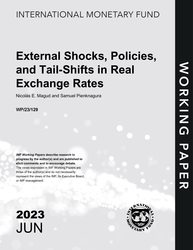
External Shocks, Policies, and Tail-Shifts in Real Exchange Rates
External Shocks, Policies, and Tail-Shifts in Real Exchange Rates
READ MORE...
Volume/Issue:
Volume 2023
Issue 129
Publication date: June 2023
ISBN: 9798400247019
$20.00
Add to Cart by clicking price of the language and format you'd like to purchase
Available Languages and Formats
| English |
Prices in red indicate formats that are not yet available but are forthcoming.
Topics covered in this book
This title contains information about the following subjects.
Click on a subject if you would like to see other titles with the same subjects.
Finance , Investments and Securities-General , Economics- Macroeconomics , Economics / General , Real exchange rates , external shocks , foreign exchange intervention , capital controls , central bank credibility , IMF working paper 23/129 , REER distribution , VIX shock , FXI effectiveness , Real effective exchange rates , Currency markets , Depreciation , Global
Summary
We use panel quantile regressions to study extreme (rather than average) movements in the distribution of the real effective exchange rate (REER) of small open economies. We document that global uncertainty (VIX) and global financial conditions (U.S. monetary policy) shocks have a strong impact on the distribution of the REER changes, with larger impacts in the tails of the distribution, and especially in economies with shallower FX markets, lower central bank credibility, and higher credit risk (i.e., weaker macro fundamentals). Foreign exchange intervention (FXI) partially offsets the impact of these shocks, especially in the left tail (large depreciations) and particularly in economies with weaker fundamentals but, more importantly, when FXI is used sporadically. Thus, our results highlight the importance of deepening FX markets, improving central bank credibility, and strengthening macro fundamentals against the potential dynamic trade-offs of overreliance on a policy that would exacerbate the previously mentioned frictions. While our results point to low effectiveness of capital flow management in preventing large REER movements, they seem to enable more impactful foreign exchange intervention in the immediate aftermath of shocks.
Copyright © 2010 - 2025
Powered by:
AIDC



